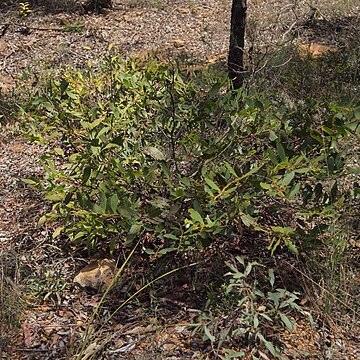Shrub or tree to 5 m high; branches arching downwards. Branchlets ±flexuose, flattened, narrowly winged, glabrous. Phyllodes often patent, narrowly elliptic, mostly 5–10 (–12.5) cm long and 10–30 (–45) mm wide, obtuse to subacute, thinly coriaceous, glabrous, with 7–9 prominent distant main veins and openly reticulate in between; pulvinus 2–3 mm long. Inflorescences 4–8 per axil in axillary fascicle or sometimes fascicles racemose on axis to 30 mm long; peduncles 8–12 mm long, glabrous; heads globular, ± 6 mm diam., 35–45 (–60)-flowered, bright yellow. Flowers 5-merous; sepals free to ½-united. Pods linear, rounded over seeds alternately on each side and shallowly to moderately constricted between them, to 15 cm long, 6–10 mm wide, thinly coriaceous-crustaceous, wrinkled ±reticulately over seeds, glabrous. Seeds longitudinal, subglobular, 4–5 mm long, dull, dark brown; funicle encircling seed.
More
An evergreen shrub. It grows to 2-6 m high and spreads to 2-4 m wide. The stem is slender and the branches are flattened and zigzag in shape. The leaves (phyllodes) are oblong and 5-10 cm long. They are 1-3.5 cm wide. They are thick and dark green. The flowers are large yellow balls about 1 cm across. The flowers occur singly. The pods are light brown. They are 8-15 cm long and 0.6-0.8 cm wide. They are flat, pointed and curved when mature.


